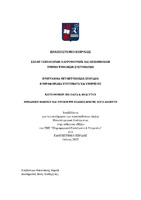Μηχανική μάθηση και πρόβλεψη επανεισαγωγής λόγω διαβήτη

View/
Keywords
Machine learning ; Πρόβλεψη ; Επαναεισαγωγή ; EDA ; ΜοντελοποίησηAbstract
Diabetes mellitus is one of the most important and widespread chronic diseases worldwide, with its incidence increasing in both developed and developing countries. One of the key quality indicators of care provided in hospitals is the patient readmission rate, that is, the percentage of patients who are readmitted to the hospital within a short time after their previous discharge. Readmission of diabetic patients places a burden both on the healthcare system and on patients’ quality of life. Frequent readmissions among diabetic patients may be attributable to several factors, such as inadequate disease management, ineffective medication, or insufficient post-discharge follow-up.
Machine learning is used to teach machines how to manage data more effectively. This is necessary because data are not always interpretable and specific patterns cannot always be identified. With the abundance of available datasets, demand for machine learning is on the rise. Many industries, from medicine to the military, apply machine learning to extract relevant information. To sum up, the purpose of machine learning is to extract insight from data.
The present study aims to develop and evaluate a machine-learning models to predict the probability of readmission within 30 days, to enable timely intervention and reduce the hospital burden. Through this work, we seek to improve patient management, promptly identify high-risk groups, and enhance the overall quality of healthcare services provided.
To achieve the above objective, the public dataset “Diabetes 130-US hospitals for years 1999–2008” was used, which includes data on hospitalizations of diabetic patients from 130 U.S. hospitals. The study includes detailed data exploration and preprocessing, handling of class imbalance, development and evaluation of six machine-learning models, as well as interpretation of the results using SHapley Additive exPlanations (techniques.
The significance of the present work lies not only in the high predictive accuracy that can be achieved, but also in providing meaningful information to healthcare professionals, enabling them to implement targeted interventions aimed at reducing readmission rates and improving the overall care of diabetic patients.


